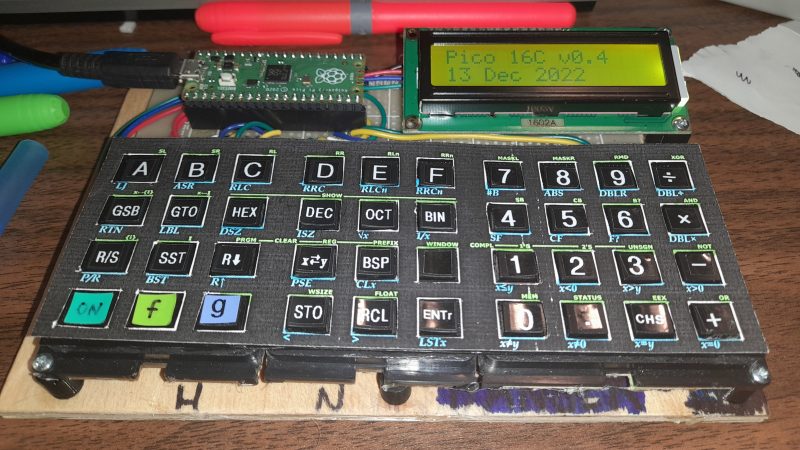The HP-16C Computer Scientist is much beloved as the only dedicated programmer’s calculator that Hewlett-Packard ever made. Most surviving examples in the world are well-used, and you haven’t been able to order one from HP since 1989. Thus, [K Johansen] set about building a tribute to the HP-16C using modern hardware.
The build relies on a Raspberry Pi Pico as the brains of the operation. As with so many classic HP calculators, it operates in Reverse Polish Notation, and includes the customary stack operations. To serve a programmer well, it’s set up to accept entry in hexadecimal, octal, decimal, and binary formats, and can readily convert between them. Beyond that, it’s equipped with the usual arithmetic operators, as well as bitwise operations like NOT, AND, and so on.
Perhaps what we love most, though, is the keypad. It was all put together with a combination of cheap AliExpress keypads, a label maker, and a laser printer. It’s a wholly DIY job, and a little rough around the edges, but it makes the calculator far easier to use.
It’s not an exact replica of the HP-16C, but the differences in operation are minor.Those wishing to build their own can grab the required files from the project’s Github page. We’ve seen replicas of other classic HP calculators before, too. If you’ve got your own mathematical projects brewing up in the lab, don’t hesitate to send them in to the tipsline!
















SwissMicros makes a modern clone. They are rad.
A good programer can do bitwise operation and converting between dez, hex and bin in there head. Only for the more sophisticated operation we need a pocket calculator. This is the reason HP stops the 16C in 89 and invented the world best calculator and call it HP48SX. And we all use the HP48 since this days for our joy! .-)
Olaf
The Windows 11 calculator has programmer mode that meets most needs and now supports graphing.
The, “A good programmer”, paradigm has shifted meaning throughout the times.
Hence the removal of this “calculator” from HP’s lineup.
Back in the days when Mel, as in: “The story of ~”, was king, this little machine was a very useful tool.
I’ve used it’s emulator to help me debug some code I wrote, which helped me understand the assembly the C-compiler I used produced a lot better.
(And allowed me to hand-optimize for speed and memory usage.)
Since today (22 sept 2023) I own the real thing, and it’s a joy to work with.
(Kudos to the writer of the emulator!)
Also HP used a method called, “Silicon on Sapphire” for making the chips in it (this was back in 1982) which only recently has gained new interest.
No modern calculator offers the same simplicity and ease of use of changing between bases, rotating
or shifting bits around, with or without carry, or 1’s or 2’s complement arithmetic, all with an arbitrary word size.
Also, if this calculator was obsolete, or surpassed, why should its replicas gain so much interest?
I wasn’t able to do Fractional non-decimal numbers on my 16C.
But was able to do them with another (Casio?).
Otherwise a great calculator.
I have a TI SR-22 that can do that.
I still have my 16C and use is daily.
My HP 16C still works also.
The HP-16C was, to wit, a ‘skunkworks’ project at Corallis. The concept is interesting, but I find it of limited utility these days; especially with the display and non-754 float.
But I love the physical format. I use my 15C daily.
The HP-16C manual has programs on page 115 onwards for converting between the 16C’s float format and what was then the proposed IEEE 754 format. Presumably they could be adapted to handle finalized 754 conversions?
Though personally I vote we switch everything else to IEEE 754-2008 decimal floats like the decimal floats in the 16C…
I still have my HP-15C and HP-16C. They compliment each other. Both work great for what they were designed for. My first 16C was either lost or stolen on a business trip not long after I graduated from college. I picked up another one (just because) a few years ago as I’d missed it and this was ‘like-new’. Cost me a bit more than my first, but worth it (to me).
Nice job there with the Pico project. Looks like it was an interesting build.
Bill and Dave are smiling.
TI had a calculator early, was it 1976?, that did computer operations, and nothing else.
Thirty years ago I got a Casio scientific that converted hex, binary, octal and did limited functions.but ten years ago I got a Sharp? that did it all, on top of a full blown scientific calculator.
I am old, but I am too young for HP calculators, it seems.
My HP 16C is called TI-34.
(But then came the TI-92 and I never needed another calculator.)
Problem is, it is hard to find a common RPN calculator now-a-days. I did get a 12C for home use though a few years ago now as that was still made. The wife doesn’t mind using it at all BTW. RPN is really nice to work with.
Dollar Tree used to sell a 10 digit scientific calculator ($1) that did hex, Dec, Oct, and bin conversion. You needed to make sure it worked before heading to the checkout, as some of them wouldn’t turn on.
RPN and RPL!
Started college with an HP35.
Anybody care to get emu48 working on the rp2040? Sounds like it already compiles on the raspberry pi / ARM…